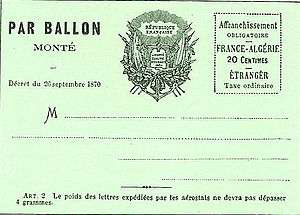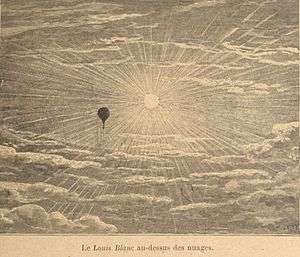Balloon mail
Balloon mail is the transport of mail (usually for weight reasons in the form of a postcard) carrying the name of the sender by means of an unguided hydrogen or helium filled balloon. Since the balloon is not controllable, the delivery of a balloon mail is left to good fortune; often the balloon and postcard are lost. A found balloon should be returned to the sender (by conventional post) with an indication of the discovery site, so that the sender can determine how far their balloon flew. Frequently balloon mail is sent as part of a balloon competition.


Historically, balloons were used to transport mail from Paris during the Siege of Paris of 1870-71. About 66 unguided mail balloons were released from Paris to communicate with the outside world, of which the great majority succeeded in delivering their cargo. As the Prussian forces surrounded the city, telegraph lines were cut and messengers were captured, shot or turned back. Two services were proposed, by ballon monté (manned balloon) and ballon non-monté (unmanned).[1] In practice only manned flights were used. After the siege, Anglo-French scientist Dr Pierre Wesby travelled to Burton-on-Trent, where in 1873 he started a business to transport mail across the Irish Sea to Dublin, from England. It is not known how this venture turned out; the records of Wesby's company were lost in 1916, when a bomb from the Zeppelin L 19 destroyed them. In 1877, a 5-cent stamp for balloon postage was privately printed in Nashville, Tennessee to carry mail on a June 18 flight of the "Buffalo Balloon" from that city to Gallatin, Tennessee. Of the three hundred stamps produced, only 23 were used.[2]
Balloon mail was sent from Przemyśl, Poland (near the Ukrainian border) during World War I.[3]
Balloon mail has been used for spreading information and propaganda materials, in particular for spreading propaganda to the population in countries with dictatorial governments. A balloon can be released from outside the sphere of influence of these governments and, wind permitting, can travel several hundred kilometers. This method of balloon mail has been used by private activists to distribute leaflets to Warsaw Pact countries from West Germany in the mid-1950s;[4] and by South Koreans to North Korea discussing the health of their leader, Kim Jong-il.[5]
References
- Loving, Matthew. (2011) Bullets and Balloons: French airmail during the Siege of Paris. Franconian Press (Kindle edition).
- The William Fekete Collection, Sale 1082, Siegel Auction Galleries, October 21-22, 2015, "New York, New York" p. 115.
- Bennett, Russell and Watson, James; Philatelic Terms Illustrated, Stanley Gibbons Publications, London (1978).
- Hearst Magazines (February 1956). "Balloon Wheel Dumps Leaflets". Popular Mechanics. Hearst Magazines. p. 151.
- Sudworth, John (10 November 2008). "Storm looms over N Korea balloons". BBC News. Retrieved 11 November 2008.
